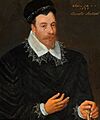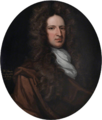Secretary of State (Kingdom of Scotland) facts for kids
The Secretary of Scotland or Lord Secretary was a very important job in the old government of the Kingdom of Scotland. Think of it like a top assistant to the King or Queen! This person helped manage many important papers and decisions for the country.
This important role started a long time ago, possibly in the 1300s. The Secretary was often also the Keeper of the Privy Seal, which meant they looked after the King's special seal used on official documents. They were considered a "Great Officer of State," a high-ranking official.
The Secretary's main duties included staying close to the King at all times. They would receive requests and ideas from people and then write down the King's answers. All official documents, like Letters Patent (special royal orders), passed through their hands. They were responsible for writing all the King's letters, orders, and important messages. If a document was very long, the Secretary would write a short summary for the King to review. Because all papers signed by the King went through the Secretary, they were responsible if anything in those papers went against the laws or the King's honor.
From 1626, King Charles I sometimes had two Secretaries working at the same time. This became a common practice after 1680, even though only one Secretary could usually attend the Scottish Parliament.
After 1603, the Secretary did not always sit in the Parliament of Scotland. This was because the Scottish monarch, who the Secretary served, was often living in England.
The job of Secretary of Scotland officially ended in 1709. However, a similar role, called the Secretary of State for Scottish affairs, existed for some years after that. You can learn more about those later roles by looking up Secretary of State for Scotland.
Who Were the Secretaries of State?
The role of Secretary of State was held by many different people throughout history. They served various Scottish monarchs, from Malcolm IV to Queen Anne. These individuals played a key part in the daily running of the Scottish government. They helped the King or Queen make important decisions and communicate with their people.
After the Treaty of Union in 1707, Scotland and England joined to form Great Britain. The role of Secretary of Scotland changed. For the new position after 1707, you can look at Secretary of State for Scotland.
Images for kids




















